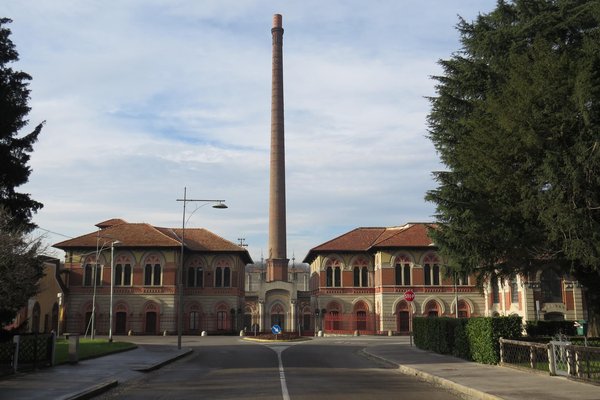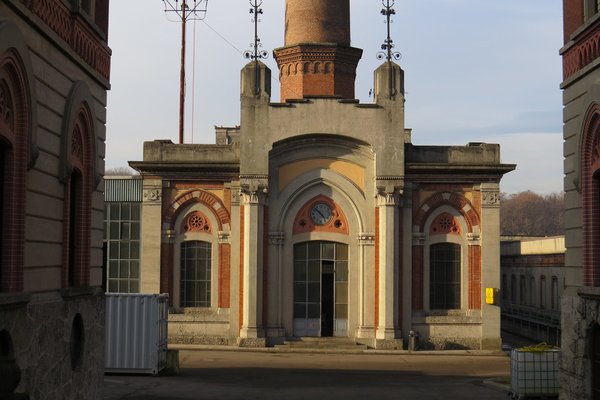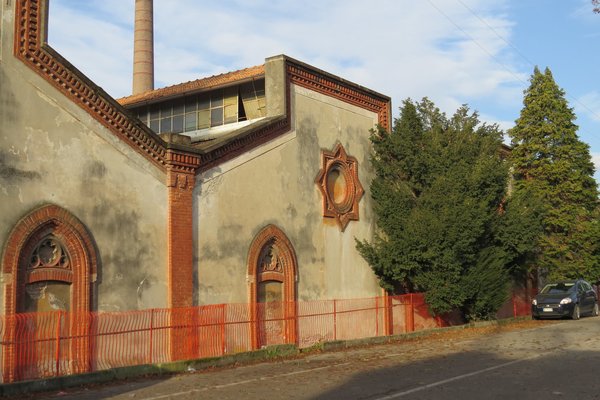Italy
Crespi d'Adda
Crespi d'Adda is a late 19th-century workers’ village.
It is one of the best-preserved examples of the phenomenon of "company towns", which were developed by enlightened industrialists in Europe and North America. The aim was to house factory workers close to their work and the raw materials, and to maintain a stable workforce by offering comfortable houses and amenities. The urban layout of Crespi d'Adda and its architectural appearance is still unchanged.
Community Perspective: The houses are still inhabited, although the factory closed in the early 21st century and maintenance seems to be lacking since. The area also isn’t set up well to receive tourists, with a clear lack of information panels or signage and few buildings to enter.
Site Info
Official Information
- Full Name
- Crespi d'Adda (ID: 730)
- Country
- Italy
- Status
-
Inscribed 1995
Site history
History of Crespi d'Adda
- 1995: Inscribed
- Inscribed
- Type
- Cultural
- Criteria
- iv
- v
Links
- UNESCO
- whc.unesco.org
- Official
-
- villaggiocrespi.it — Villagio Crespi d'Adda
- Related
-
- crespidadda.it — Link
- en.wikipedia.org — Wikipedia on Crespi d'Adda
All Links
UNESCO.org
- whc.unesco.org — whc.unesco.org/
Official Website
- villaggiocrespi.it — Villagio Crespi d'Adda
Related Resources
- crespidadda.it — Link
- en.wikipedia.org — Wikipedia on Crespi d'Adda
News Article
- Nov. 25, 2013 ilqi.it — Percassi buys former Crespi D'Adda factory
Community Information
- Community Category
- Secular structure: Factories and industry
- Human activity: Urban planning
Travel Information
Lombardy hotspot
Recent Connections
-
Perfect Inscriptions
1995 -
Hydro Power Stations
"More serlous is the condition of the s… -
In private ownership
Bought by the company of Antonio Percas…
Connections of Crespi d'Adda
- Trivia
-
-
Modelled after
Modelled after Saltaire "Crespi D?Adda in Italy .. consciously uses Saltaire as a model even down to the derivation of its name. Founded in 1875 by Cristoforo Crespi, as with Saltaire, it combines its founder?s name with the river on which it sits. It too displays an architectural unity - the numerous community buildings were built to a common Italian Gothic motif between 1893 and 1925." (Nom File for Saltaire) -
In private ownership
Bought by the company of Antonio Percassi in October 2013
-
- Architecture
-
-
Art Nouveau
The Cemetery is dominated by the Crespi family mausoleum, an Art Nouveau structure, the work of Gaetano Moretti. (Unesco website) -
Ideal City
-
- World Heritage Process
-
-
Perfect Inscriptions
1995
-
- Human Activity
-
-
Locations for playing sport
sports centre -
Company town
-
Textiles
Started by the textile manufacturer Cristoforo Benigno Crespi
-
- Constructions
-
-
Mausolea
the Crespi family mausoleum -
Theatres and Opera Houses
-
Latrines
public lavatories -
Pyramids
Crespi chapel - a decorated tower-pyramid (official website) -
Hydro Power Stations
"More serlous is the condition of the small hydroelectrlc power station, which ls an excellent example of early 20th centurv Art Nouveau architecture. lts technical equipment ls still in situ and plans are being prepared for its rehabilitation as an industrial heritage museum." (AB eval)
-
- Timeline
-
-
Built in the 19th Century
from 1878
-
- WHS Hotspots
-
-
Lombardy hotspot
Milan hotspot
-
- WHS Names
-
-
Named after individual people
Cristoforo Benigno Crespi, founder and cotton manufacturer
-
News
- ilqi.it 11/25/2013
- Percassi buys former Crespi D'Adda…
Recent Visitors
Visitors of Crespi d'Adda
- 4lex
- Adam Hancock
- Adrian Turtschi
- Afshin Iranpour
- Alberto Rodriguez Gutierrez
- Alexander Barabanov
- Alexander Lehmann
- Alex Goh
- A. Mehmet Haksever
- Ammon Watkins
- Ana Lozano
- Antonio J.
- Argo
- Astraftis
- Atila Ege
- BaziFettehenne
- Bill Maurmann
- Bin
- Bram de Bruin
- Brendan Carroll
- Caspar
- Cezar Grozavu
- christof
- Christoph
- Christravelblog
- Claire Bradshaw
- Clyde
- Cristina Erba
- Csaba Nováczky
- CugelVance
- Cyberczar
- Dagmara
- Daniela Hohmann
- Daniel Chazad
- Dan Pettigrew
- David Aaronson
- David Berlanda
- Dimitar Krastev
- Dimitrios Polychronopoulos
- Dolemite92
- Dorejd
- Dr. Caligari
- Dwight Zehuan Xiao
- Elaine McArdle
- Elia Vettorato
- Elis
- Els Slots
- Eva Kisgyorgy
- Fan Yibo
- Farinelli
- Femke Roos
- George Gdanski
- GeorgeIng61
- Harald T.
- Harry Mitsidis
- Hasco
- henrik_hannfors
- Hubert
- Iain Jackson
- Igloo
- Ilya Burlak
- Ivan Rucek
- Jakob F.
- Jana and Matt
- Janina Lehmann
- Jan-Willem
- Jarek Pokrzywnicki
- Jasam
- Jean Lecaillon
- Jeffrey Chai
- Jens
- Jezza
- Joel on the Road
- John Smaranda
- Jonas Hagung
- Jonas Kremer
- Joyce van Soest
- KarenBMoore
- Kbecq
- Klaus Freisinger
- Knut
- La Concy
- Lara Adler
- LaVale
- Lisu Marian
- Loic Pedras
- Luboang
- Lucas Del Puppo
- Lucio
- Luis Filipe Gaspar
- Maciej Gil
- marcel staron
- MarcoB_0
- Martinacurra88
- Martina Rúčková
- Marty
- MaxHeAnouBen
- MaYumin
- MH
- Michael Turtle
- Mihai Dascalu
- Mikko
- MMM
- MoPython
- nan
- Nasebaer
- Nick M
- Nihal Ege
- Patrik
- Paul Schofield
- PeterH
- Peter Lööv
- Petteri
- Philipp Leu
- Philipp Peterer
- phillipmeng
- Piotr Wasil
- Rafał Kałczuga
- Ralf Regele
- Randi Thomsen
- Remigiusz
- Roel Sterken
- Roger Ourset
- Roman Bruehwiler
- Roman Raab
- Sabrina Liebehentschel
- Samato
- Samy G
- Schnitzel
- Sergio Arjona
- Shandos Cleaver
- SirLoydd
- Solivagant
- Stanislaw Warwas
- Stefan A. Michelfeit
- stephanvermeulen
- Stijn
- Svein Elias
- Szucs Tamas
- Taotao Chen
- Tarquinio_Superbo
- Tatiana Nikulnikova
- TheTravelingRanger
- Thomas Buechler
- Thomas van der Walt
- Thorben
- tommasorossotti
- tony0001
- triath
- Tsunami
- usagi1974
- Vanessa Buechler
- Walter
- WILLIAM RICH
- Wojciech Fedoruk
- Xiquinho Silva
- Yevhen Ivanovych
- Zach
- Zoë Sheng
Community Reviews
Show full reviews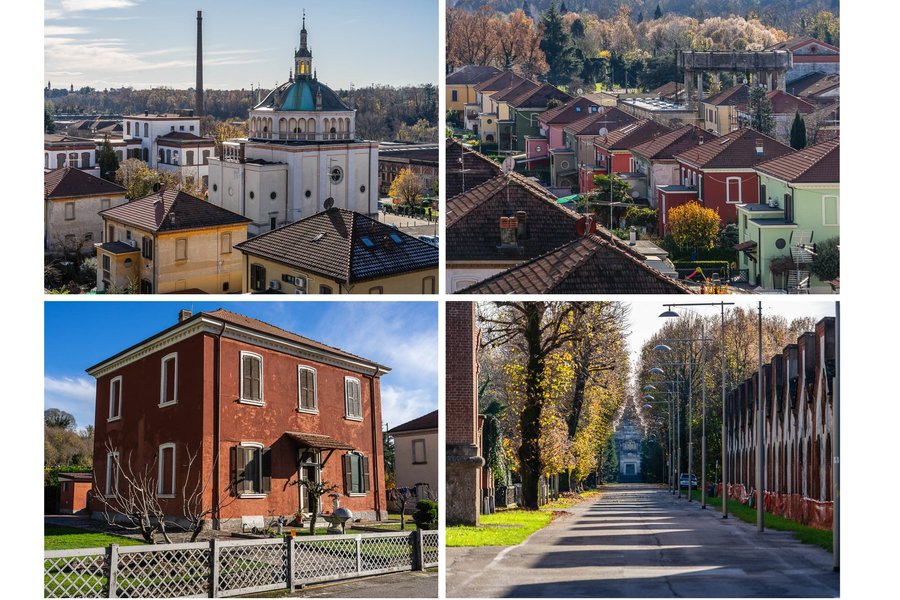
I visited Crespi d'Adda in November of 2025. It never especially struck my fancy on the many previous visits to Northern Italy, and I basically went there for a tick on my list. What I saw left an unexpectedly pleasant and expectedly underwhelming impression in equal measure.
There weren't many people around. Crespi d'Adda is a living town - I saw people attending to things in their gardens, hanging laundry and such, and also occasional pedestrians going on errands. But it did not feel like there were any other visitors besides me. At the visitor center, the welcome desk was not tended, but a guy came out of a back room, having had probably heard the sound of my steps in the overall silence. He was then visibly disappointed with the fact that I did not need to engage him beyond simple greetings, being content with reading information on the wall boards.
Guided tours of the factory and the town in general are possible with certain advance preparation in warmer months, but my plans anyway included solely walking around the place. I started with the elevated viewpoint on the northern edge, and then traversed the three main parallel streets of the workers' housing blocks. Painted in different hues and surrounded by greenery, the houses offer a pleasant visual despite their seeming uniformity. Each is enclosed within a garden, which was obviously unheard of up to that date in the age of industrialization. Many have blind side windows, which is a …
Keep reading 0 comments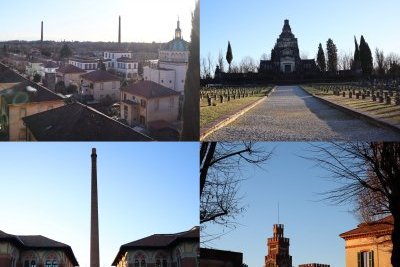
I visited Crespi D'Adda on the 20th of December this year. I had been thinking about this day trip for quite a while and, now that I have finished my exams, I took a day for myself to explore this little town just over an hour from where I live. I got off at the wrong bus stop and walked half an hour to reach it (a time it would have taken me even at the right stop). First advice: don't visit in December like I did because you're going to miss much of the experience! Most of insude spaces (like the hydroelectric central or the Crespi house) are closed from December to February and are only available through guided tours from March to November. Still, I had quite the good time. Since the day was sunny, I walked around most of the day and got to see some of the key sites of the town (although only from the outside) like the church, the main buildings of the factory, the Crespi family house, the graveyard (with an absurdly big mausoleum for the Crespi family) and of course the single-family houses.
In a day you should manage to see just about everything in the town, even better if you go by car and don't have the time costraints I had. A few practical tips: I suggest stopping by the Crespi Cultura association in the eastern part of the town which can give you a map of the city with …
Keep reading 0 comments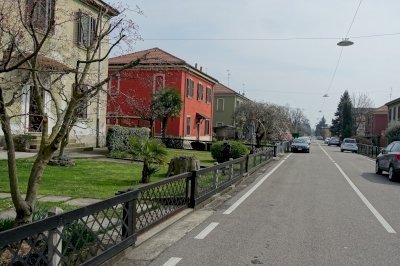
Having been to Milan repeatedly over the last decade, and knowing I would be back the next year chasing more WHS, for a long time I never made a dedicated effort to get to Crespi d'Adda, even though it was always well within reach. The information I had picked up regarding the site never impressed me much, so that I rather spend my time ticking off other WHS in the area.
Eventually, mainland Italy had winded down to Crespi d'Adda, so I had to go. Now, I would argue that I probably enjoy industrial sites more than the average visitor; same is true of gardens. And still I found the experience underwhelming. It may have been the weather, a cold, foggy spring day. Or the emptiness of the place. And it sure didn't help that the factory/museum was closed that day. But even if I try to discount these factors, the site never came together for me, unlike e.g. Saltaire or New Lanark.
Crespi d'Adda was an Italian company town for a textile factory. It's located directly on the Adda river which provided hydropower to operate the factory. It was founded in 1878 and grew till the 1920s. The factory continued to operate till 2004 when it was shutdown. Today, it's a sleepy town between Bergamo and Milan, probably housing commuters. If you come to visit, structures of note are the factory, the church, the cemetery, and the hydro power plant as well as the castle.
Reading …
Keep reading 0 comments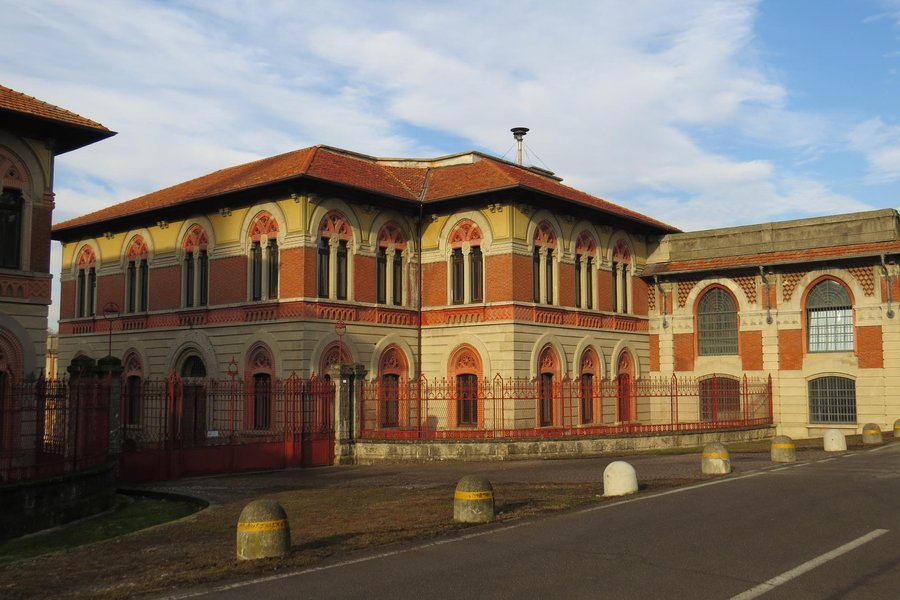
I made a last-minute decision to visit Crespi d'Adda because I had arrived quite early in Milan from Modena and had a few hours to spare before my flight home from Malpensa. It took me quite a long time to get there because it was a Sunday and the buses only go once an hour from outside the Gessate Metro Station. From Trezzo sul Adda, it is quite a long, but reasonably pleasant walk to the site - you can download a map from the site of Crespi's tourist office. I only had about 30 minutes or so before I had to take the next bus back, so I could only take a quick look around, but I had the impression that this was sufficient. There is really not a whole lot to see, just a few private and public buildings, and not much in the way of signage or explanations. The factory and the church are somewhat impressive (as is the owner's villa in the park that can be glimpsed through the trees), but nothing really special. I guess Crespi's inscription is justified because of its value as a company town, but from a tourist perspective, it doesn't offer very much (and on a Sunday afternoon, the place was practically dead).
Keep reading 0 comments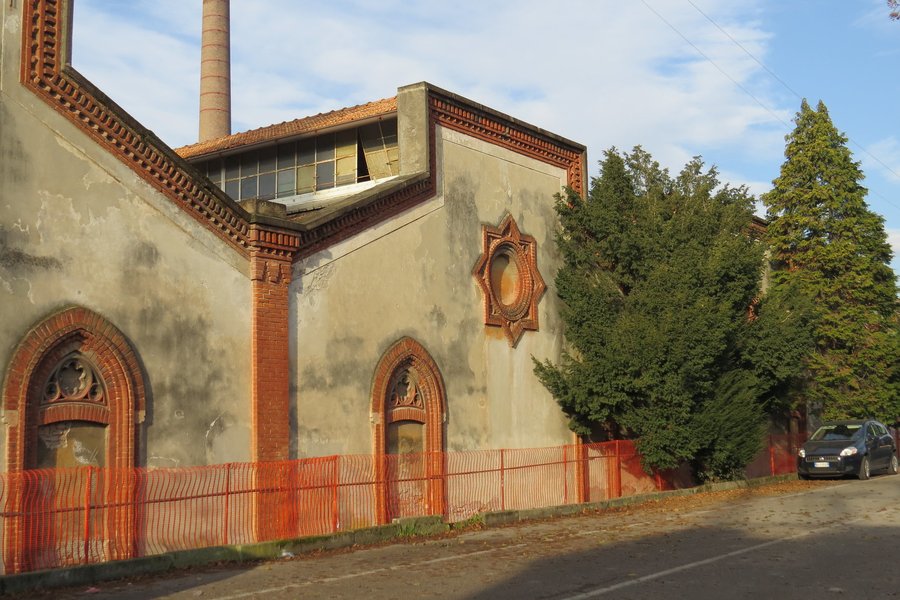
Reading the previous reviews, I was expecting a desolate WHS in decay. When I arrived however on a sunny Sunday morning, the town looked bright and I certainly wasn’t the only visitor. Local people streamed out of the church, a service had just ended. A group of photographers was trying creative shots of the tree-lined streets and the industrial buildings. And numerous people were using the streets (that are low on traffic) for jogging or cycling. I parked my car in the town center and went out to explore too.
The main attraction is the former factory. It’s an iconic sight (see larger picture above), architecturally interesting. Unfortunately, the building is closed, and no effort has been made to turn it into something informative about its past. I wonder what the new owners of Percassi will do about it – they seem to want to house their business headquarters in the factory buildings, but will that mean these buildings stay closed for tourists?
In all, I wandered around Crespi d´Adda´s streets for about an hour. The church and school are worth a look, and I even walked uphill to try and get better views of the factory owner´s palace. The design of the town was inspired by English examples, and certainly, Saltaire springs to mind. The rigid street plan and the cubical houses are similar. This Italian version however has more flair. The houses aren´t so close together, are painted in different colours and all have good gardens. …
Keep reading 0 comments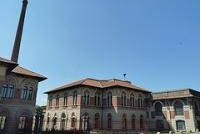
I visited this WHS in August 2013. It is definitely not the best WHS in Italy and most certainly not the most visited one either. More should be done to raise awareness on this site on a national level and to make it more accessible/interesting. I drove to Capriate San Gervasio to visit Crespi d'Adda. I arrived early in the afternoon on a sunny August day and pretty much everything was empty and closed (including Crespi Cultura which was supposed to be open!). The site is not looked after especially since the textile factory closed down. There were broken windows, signs of vandalism, overgrown grass on the pavement and the main road leading to the factory is blocked since some of the buildings are falling down due to lack of maintainance and therefore it is not safe for pedestrians or motor vehicles to keep it open. There aren't any information signs apart from the UNESCO sign just before entering the village and a small sign just next to the closed factory. The main church (replica of Busto Arsizio) is well kept as is the School nearby, and a short walk uphill next to the biggest villas gives you a good view of the urban layout. I'm not a big fan of industrial sites although there are pleasant exceptions such as Salins-les-Bains or the Woudagemaal, however Crespi d'Adda desperately needs funds and enough political will to maintain the site, install more informative signs and if possible open up the factory to …
Keep reading 0 comments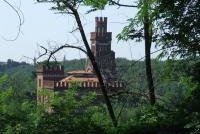
Although the factories fell silent in 2003, the residential areas are still occupied and well maintained. The church, school and theatre are periodically open to visitors. But the Villa Padronale, the castle residence of Cristiforo Crespi is not open.
I reached Crespi d'Adda from Milan by taking the Matro to Gessate, then bus #Z310 to the terminus at Trezzo sul Adda. From there I crossed the bridge over the river to Capriate and followed the riverside road to the site.
Keep reading 0 comments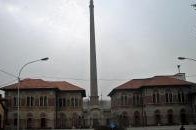
I have been once in the nice utopian company town of Crespi d’Adda, constructed from 1878 by the architects Angelo Colla, Ernesto Pirovano, Luigi Cavenaghi and Gaetano Moretti for the enlightened textile manufacturer Cristoforo Benigno Crespi to meet the workers’ need. The town is in a geometrically regular form and it is divided in two parts by the main road from Capriate San Gervasio. On the right, on the left bank of the river Adda, is the single block of the factory, projected by Pirovano, with decorations in medieval style. It is divided in sections: twisting, spinning, weaving, dyeworks, steam engine, boiler, power station, storehouses and offices. On the left, are the houses of the workers, the foremen and the executives, constructed in a rectangular grid of roads in three lines, in original plans two-storeyed buildings for several families, each with four rooms, and now individual family houses with a small garden and a vegetable garden, the latter separating the houses from the lavatories in the rear. The earlier houses have different stylistic and layout grounds. On the main square there is the church, projected by Cavenaghi following Bramante’s Temple of Santa Maria in Piazza in Busto Arsizio (the home of the founder of the company) and built from 1891 to 1983, the school, theatre and minor palaces. The castle(Crespi’s residence) with the stables, projected by Pirovano and completed in 1897, recalls the Romantic Gothic period using the ceppo stone of Capriate San Gervasio, fired bricks and cement and is …
Keep reading 0 comments
